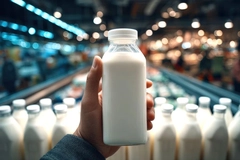Plastic phase out? Experts discuss whether a plastic-free future is possible or even necessary
The plastic-free movement – a laudable endeavor or an impractical preoccupation?

07 Jun 2019 --- As environmental concern continues to rise globally, consumers are turning towards more sustainable practices, especially when it comes to the packaging of goods. Sustainability oriented movements such as “zero waste,” increasingly gain supporters. Industry is responding proportionately with packaging that is recyclable, reusable or biodegradable. As far as policy is concerned, this year saw the European Parliament approve a sweeping ban on single-use plastics, via The Single Use Plastics Directive (SUDP). Although plastic has become somewhat demonized among some groups, whether a plastic-free world is realistic, or even necessary, remains to be seen.
“The so-called plastic-free movement is a laudable endeavor, however, it would be impractical to think that the entire packaging industry could move to entirely plastic-free packaging,” Andy Sweetman, Sales & Marketing Manager EMEA at Futamura, tells PackagingInsights. “There are certain types of plastic, such as PET bottles that have a well-managed recycling infrastructure in place and have their place in the packaging world.”
Previously, a US and Canadian study into the environmental effects of plastics concluded that plastics are more sustainable than the material alternatives in terms of energy use, water consumption, solid waste, greenhouse gas emissions, ozone depletion, eutrophication and acidification. The study found that replacing plastics with alternative materials such as paper and paperboard, glass, steel, aluminum, textiles, rubber and cork would result in significant net negative environmental impacts.
Noel Morrin, EVP and Global Head of Sustainability at StoraEnso, tells PackagingInsights that replacing all fossil-based plastics is no a mean feat, but at least the amount of plastic industry uses can be reduced. “We can start by targeting unnecessary plastics, the kind that we can easily live without or the kind that we can replace with a renewable alternative that is recyclable and to a high degree compostable,” he says.
Plastic-free or sustainable plastics?
Where the infrastructure is in place and where the materials are practical to collect and separate, recyclable plastic packaging is a good option, Sweetman notes. “There are food safety regulations to be considered when pushing for 100 percent recycled packaging, especially for direct food contact materials which would not comply with strict food safety rules using recycled plastics. Effectively, the recycled materials need to be dedicated to other non-food uses.”
 Major retailers are switching to a zero waste approach with plastic-free fruit and vegetable zones.However, the use of non-renewable fossil-based resources remains a concern. It is important to know that certified compostable materials are recyclable as well, through the organics recycling stream, he notes.
Major retailers are switching to a zero waste approach with plastic-free fruit and vegetable zones.However, the use of non-renewable fossil-based resources remains a concern. It is important to know that certified compostable materials are recyclable as well, through the organics recycling stream, he notes.
Morrin explains that as there are so many different types of plastic that cannot be mixed in the recycling process, the recycling of plastics is also challenging. The vast majority of plastic packaging waste gets burned and as a result release carbon emissions. “Only around 42 percent of plastic packaging gets recycled, while the corresponding number for paper and cardboard packaging stands at 85 percent. Obviously, it would be great for the environment for companies to recycle all plastic, but currently, the statistics are not encouraging,” he notes.
“Moreover, ‘recyclable’ alone is not enough because recycling is dependent on local infrastructures, i.e., whether there is a possibility for consumers to return their packaging to recycling, for example,” Morrin adds.
Sustainable plastic alternatives
The push from regulators to recycle, coupled with the plastics ban, may boost the development of innovative materials, according to Sweetman. “We may lose access to certain raw materials we used in the past, but conversely, we are now using renewable and compostable polymers that were not on our radar 20 years ago.”
Sweetman also says, however, that there are many applications where a switch to plastic-free could be a viable and beneficial move. For many packaging applications, compostable materials can now provide the same protective properties as conventional plastics and can be organically recycled at home and/or via industrial composting methods.
“We can replace many kinds of plastics with renewable, recyclable materials that are sometimes also compostable. Plastics replacement is already a very active industry but naturally regulation can spur further innovation,” says Morrin.
With this in mind, Futamura released NatureFlex, a range of specialty packaging films made of wood-pulp from managed plantations. “Many premium tea bag producers are now using our NatureFlex films so that the flavor-protecting wrappers are as compostable as their innovative teabags,” Sweetman says.
Stora Enso is working on materials that are applicable for the packaging industry such as fiber technology which enables single-use products that are “sustainable by design.” Other applications include Micro Fibrillated Cellulose (MFC) which has the potential to replace flexible plastic in certain end uses, such as barriers and screw caps in liquid and food packaging. The company’s plastic alternative, coined Sulapac, aims to develop straws made of wood that can biodegrade in marine environments.
 Water bottle made of PET plastic “Wood is a viable alternative to plastic and we believe that anything that is made of fossil-based materials today can be made from a tree tomorrow,” Morrin adds.
Water bottle made of PET plastic “Wood is a viable alternative to plastic and we believe that anything that is made of fossil-based materials today can be made from a tree tomorrow,” Morrin adds.
“There are a number of biobased and biodegradable materials that are viable sustainable alternatives to conventional plastic packaging, such as, PLA, Tipa film, PBSA, PHA and pulp (for trays), to name just a few. There are also sustainably derived so-called ‘drop-in’ bioplastics such as BioPET and Bio-PE which can follow the recycling streams for rigid PET and rigid PE already,” Sweetman explains.
Major retailers phase out plastic packaging
Previously, a Greenpeace UK report concluded that supermarkets have a stronger focus on recycling plastic over the reduction in the use of the material. This mindset has led the ten leading UK supermarkets to contribute over 810,000 tons of single-use plastic to the market every year, the report notes.
To tackle plastic waste many retailers are now adopting a more zero waste approach. British retailer and supermarket Marks & Spencer (M&S) removed plastic packaging and “best before” stickers from over 90 lines of fruit and vegetables in a UK trial. The high-end grocer already phased out 75 million pieces of plastic cutlery given out in its stores each year and replaced two million straws with paper alternatives as part of its plastics plan, which aims to remove 1,000 tons of plastic packaging.
Last month, retailer Morrisons announced plans to introduce plastic-free fruit and vegetable zones across many of its UK stores. Customers will be able to choose from up to 127 varieties of fresh produce and buy them loose or put them in recyclable paper bags. Premium UK grocer Waitrose and Partners, this week, also launched a dedicated refillable zone in one of its stores. Shoppers can bring their own containers to transport dried goods such as pulses, frozen fruits and beverages, and pick up packaging-free fruit and vegetables, among other stripped back offerings.
Future trends
Sweetman predicts that brand owners and retailers will move towards simplified materials that can be mechanically recycled on a practical basis. But where conventional recycling is impractical, then organically recyclable packaging may be a more practical solution; delivering renewable energy and natural soil improvement benefits.
The packaging market is becoming more sophisticated as consumers are more knowledgeable and demanding sustainable solutions, while brand owners are becoming more proactive in meeting those demands. The key driver here is to develop sustainable packaging materials that can compete with plastics also on price and functionality. Once that is possible, plastic may no longer be a viable option, Morrin concludes.
By Kristiana Lalou











